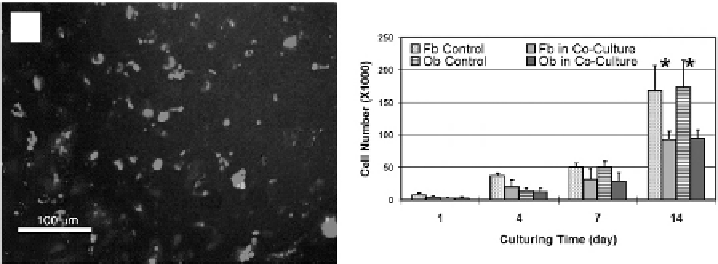Biomedical Engineering Reference
In-Depth Information
deposition of collagen type X were observed (Fujioka et al. 1998). Based on these
observations, Lu and Jiang (Lu and Jiang 2006) proposed a working hypothesis
for interface regeneration, which stated that heterotypic interactions between
osteoblasts and fi broblasts can lead to phenotypic changes or trans-differentiation
of osteoblasts and/or fi broblasts that will result in interface regeneration. In addi-
tion, these interactions can promote the recruitment of progenitor or stem cells to
the tendon-bone interface. Infl uenced by these heterotypic cellular communica-
tions, stem cells can differentiate into fi brochondrocytes and are responsible for
fi brocartilage formation.
To test this hypothesis, several
in vitro
studies evaluating the role of
osteoblast - fi broblast interactions on interface regeneration have been reported
(Jiang, Nicoll, and Lu 2005; Tsai et al. 2005; Wang et al. 2007; Wang and Lu 2005).
Both co-culture and tri-culture models of interface-relevant cell types have been
used to determine the effects of cell communication on the development of fi bro-
cartilage - specifi c markers
in vitro
. Wang et al. conducted the fi rst reported study
to examine interactions between ligament fi broblasts and osteoblasts (Wang et al.
2007), where a 2D co-culture model permitting both physical contact and cellular
interactions was designed to emulate the
in vivo
condition in which the tendon is
in direct contact with bone tissue following ACL reconstruction. In this model,
osteoblasts and fi broblasts were fi rst seeded on opposite sides of a tissue culture
well. The cells were separated by a hydrogel divider preformed in the center of
the well. Once the cells reached confl uence, the divider was removed, allowing the
osteoblasts and fi broblasts to migrate and interact within the interface region
(Figure 17.2 A).
It was found that osteoblast-fi broblast interaction led to a decrease in cell
proliferation (Figure 17.2B), a reduction in osteoblast-mediated mineralization,
accompanied by an increase in the mineralization potential of fi broblasts.
(b)
(a)
Figure 17.2.
Effects of Heterotypic Cellular Interactions on Cellular Phenotypes. A)
Co-culture
of fi broblasts (green, CFDA-SE) and osteoblasts (red, CM-DiI) at the Interface region
(bar = 100
m). B) Effects of co-culture on cell growth (Wang, Shan, Choi, Oh, Kepler, Chen, and
Lu 2007). The co-culture of fi broblasts and osteoblasts led to decreased proliferation of each
cell type when compared controls (*p
μ
<
0.05). (See color insert.)

Search WWH ::

Custom Search